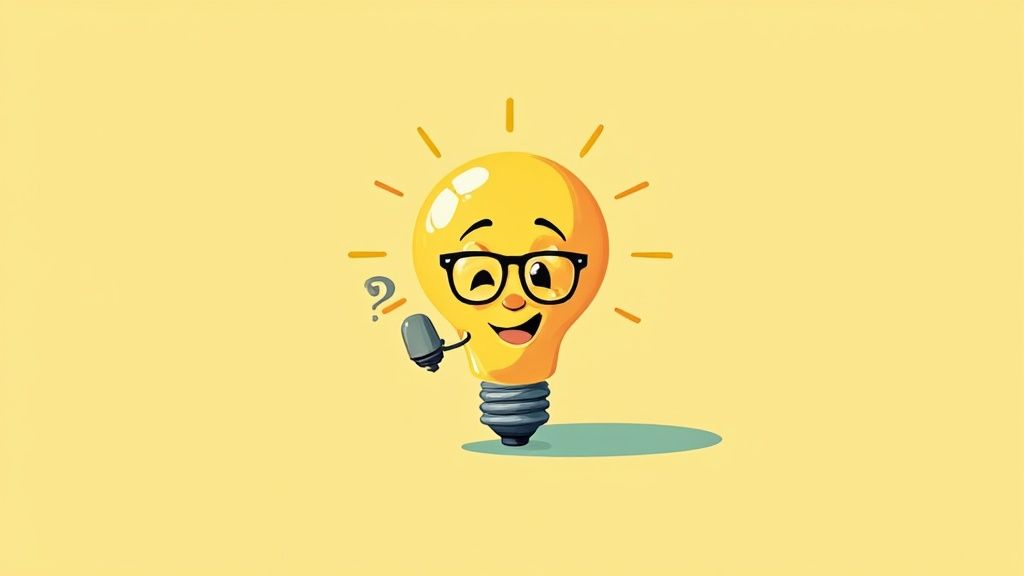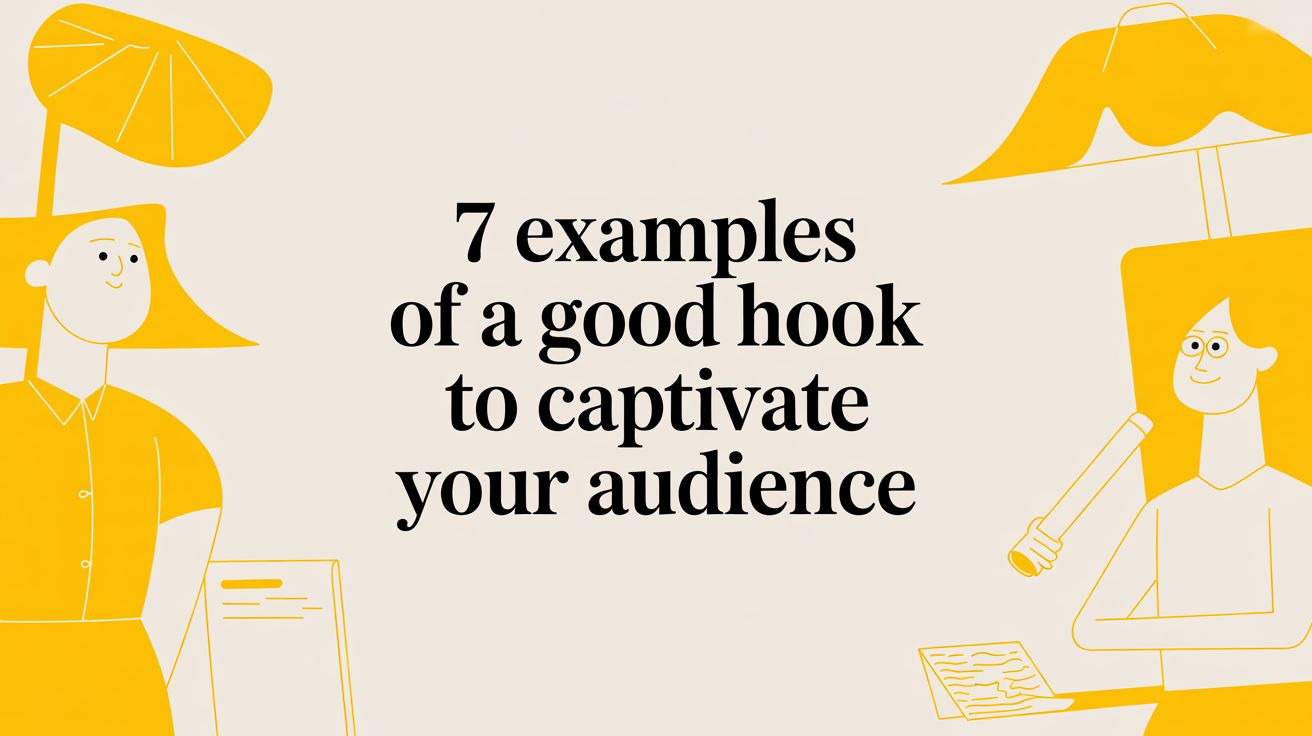You have a brilliant idea. A killer presentation. A game-changing report.
But none of it matters if you can't get past the first five seconds.
That's the hard truth. Your audience, whether they're in a boardroom or scrolling their feed, makes a split-second decision: lean in or tune out. This is where a powerful hook makes all the difference. It’s the key that unlocks your audience's attention and makes them want to hear what you have to say next.
A great hook makes them think, "Yes, that's me," or "I need to know more." But what is an example of a good hook that actually works? How do you craft one that feels authentic and connects instantly?
This guide breaks down 7 effective hooks, from shocking stats to personal stories, with clear examples you can use today.
1. The Shocking Statistic Hook
This hook grabs your audience with a surprising or alarming number. It leverages our natural curiosity for cold, hard facts and immediately establishes your credibility.
By presenting a statistic that challenges a common assumption, you create a knowledge gap that your audience desperately wants you to fill. It's a direct path to making your topic feel urgent and important.
The Strategic Breakdown
The magic here is psychological. Our brains are wired to notice anomalies. When you present a number that defies expectations, you trigger an immediate "Wait, what?" response.
This jolt forces your audience to lean in, eager for the explanation that follows. It positions you as an expert with valuable, non-obvious information.
Key Insight: A shocking statistic isn't just a fact; it's a narrative device. It creates instant conflict between what your audience thinks they know and a new reality you're about to reveal.
Examples in Action
- For a Pitch Deck: "By 2030, the global cybersecurity workforce will have a talent shortage of over 85 million people. That's a massive, expensive problem we're built to solve."
- For a Marketing Presentation: "Did you know that 92% of consumers trust peer recommendations over any other form of advertising? Yet, most marketing budgets still go to the least trusted channels."
- For a Social Media Post: "A single teaspoon of neutron star material would weigh about 6 billion tons. Let's explore the physics that makes this possible."
How to Use This Hook
- Find a Counter-Intuitive Fact: Dig through research or industry reports for a statistic that makes even you do a double-take.
- State It Clearly: Deliver the number without preamble. Let the statistic do the heavy lifting. Pause to let the impact sink in.
- Connect It to Your Message: Immediately bridge the gap between the stat and your presentation's purpose. Explain why that number matters to your audience, right now.
With a tool like GenPPT, you can drop this statistic onto your title slide to set the tone instantly. Just add the number in a large font with a brief, punchy question to create an immediate anchor for your entire presentation.
2. The Rhetorical Question Hook
This hook invites your audience directly into the conversation. You pose a question they aren't meant to answer out loud, but one that sparks internal dialogue.
By prompting this immediate mental engagement, you transform passive listeners into active participants from the very first sentence.
This is an effective example of a good hook because it frames your presentation as a solution to a question your audience is now asking themselves.

The Strategic Breakdown
A rhetorical question creates an instant, personal connection. Unlike a statement, a question demands a cognitive response. It makes the audience's mind search for an answer, tying your subject directly to their own lives.
This technique bypasses intellectual defenses and goes straight for curiosity and self-reflection.
Key Insight: A great rhetorical question doesn't just ask something; it implies a shared problem. It makes your audience think, "Yes, I've wondered about that too," creating an immediate bond.
Examples in Action
- For a Pitch Deck: "What if you could cut your team's admin workload by 50% starting next week? Let's explore how that reality is closer than you think."
- For a Marketing Presentation: "How many times have you clicked away from a website because it was too slow? Your potential customers are doing the same thing."
- For a Social Media Post: "Is it possible the historical event we've always accepted as fact was shaped by a narrative we've never questioned?"
How to Use This Hook
- Identify a Core Pain Point: Think about the central challenge your audience faces. Frame it as a "What if...?" or "Have you ever...?" question.
- Keep it Open-Ended: Avoid simple yes/no questions. Your goal is to provoke thought, not to get a one-word mental answer.
- Answer It Immediately: Don't leave your audience hanging. Use the body of your presentation to answer the question you just posed. For more tips on this, explore our guide on how to make presentations more engaging.
When building your deck, use a tool like GenPPT to place your rhetorical question on the title slide in a bold, compelling font. This ensures your audience starts pondering your core message before you even say a word.
3. The Personal Story Hook
This hook bypasses your audience's analytical brain and goes straight for the heart. You open with a brief, compelling personal story that creates an immediate emotional connection.
By leveraging the universal power of storytelling, you make your topic instantly accessible and memorable. It’s a direct path to building trust and showing the human side of your data.

This is an incredibly effective example of a good hook because it transforms an abstract topic into a tangible, human-centered narrative.
The Strategic Breakdown
The power of an anecdote lies in its ability to create instant empathy. When you share a moment of vulnerability or a relatable struggle, your audience sees themselves in your story.
This shared experience forges a bond that is far more powerful than any fact or figure alone. It shifts the dynamic from a formal presentation to a personal conversation.
Key Insight: A personal story isn't just an introduction; it's a bridge. It connects your personal experience to a universal truth, inviting your audience to walk across it with you.
Examples in Action
- For a Business Pitch: "Standing in the airport at 3 AM with only $200 in my pocket, I realized the old way of managing travel expenses was broken."
- For a Wellness Talk: "When my daughter looked up from her iPad and asked why I was always on my phone, I didn't have a good answer. That one question forced me to confront my relationship with technology."
- For a Career Seminar: "I'll never forget the cold dread I felt when my boss told me I was fired. But looking back, it was the best thing that ever happened to me. Here’s why."
How to Use This Hook
- Identify a Relevant "Micro-Story": Think of a pivotal moment, a small failure, or a surprising realization that directly relates to your presentation's theme. Keep it short.
- Lead with Emotion: Start your story at the peak of the action or emotion. Use sensory details to make it vivid and memorable for your audience.
- Bridge to the "Big Idea": After the brief anecdote, explicitly connect it to your topic. Use a phrase like, "And that's exactly why we're here to talk about..."
With GenPPT, you can use your story to frame the entire presentation. Place a powerful quote from your anecdote on the title slide to build immediate curiosity and set an authentic, human tone.
4. The Vivid Description Hook
This hook transports your audience directly into a moment or a place. By painting a sensory-rich picture with words, you tap straight into emotion and imagination.
It’s a narrative technique that makes your abstract idea feel tangible and immediate, compelling your audience to see the world through your eyes from the start.
This is a compelling example of a good hook because it creates an immersive experience that forges an instant emotional connection.
The Strategic Breakdown
This hook creates a "mental movie." When you describe a scene using specific sights, sounds, and feelings, your audience's brains begin to construct that reality.
This active participation makes them more receptive to your message. You aren't just telling them something; you're making them feel something first.
Key Insight: A scene-setting hook isn't just an introduction; it's an invitation. You are welcoming your audience into a shared experience, making your topic a story they are now a part of.
Examples in Action
- For a Pitch Deck: "Imagine a sterile, white server room humming at a constant 68 degrees. Now, picture a single bead of condensation forming on a pipe overhead. That tiny drop is a multi-million dollar catastrophe waiting to happen."
- For a Marketing Presentation: "The coffee shop buzzed with espresso machines and whispered conversations. This is the atmosphere our new campaign aims to recapture."
- For a Social Media Post: "Sweat dripped down my temples as I stared at the blank page, the cursor blinking mockingly. In that moment of writer's block, the central question of my dissertation finally became clear."
How to Use This Hook
- Isolate a Pivotal Moment: Think of a single, powerful image that encapsulates the core problem or theme of your presentation.
- Engage the Senses: Write 2-3 sentences that appeal to sight, sound, or feeling. Use strong verbs and specific nouns.
- Bridge to Your Core Message: After painting the picture, create a smooth transition that connects the scene directly to your topic.
With a tool like GenPPT, you can pair this hook with a powerful, full-bleed image on your title slide. Let your descriptive words provide the context while a high-quality visual makes the scene even more immediate.
5. The Bold Claim Hook
This hook throws down a gauntlet. It opens with a provocative or surprising assertion that directly challenges a deeply held belief or conventional wisdom.
By taking a contrarian stance, you create immediate intellectual tension and ignite curiosity, compelling your audience to stay and hear your justification.
This is a powerful example of a good hook because it positions you as a thought leader who isn't afraid to question the status quo.
The Strategic Breakdown
The power of this hook is rooted in cognitive dissonance. When you present a statement that clashes with your audience's existing worldview, their brains instinctively seek resolution.
They need to know why you believe something so contrary to popular opinion. This instantly frames your presentation as the defense of a fascinating argument.
Key Insight: A contrarian statement isn't about being argumentative; it's about reframing a problem. It signals to your audience that you see the world differently and have a unique perspective worth their attention.
Examples in Action
- For a Business Presentation: "Everything you’ve been taught about leadership is wrong. True influence isn't about top-down authority; it's about radical transparency."
- For a Marketing Pitch: "The most productive people in our industry don't use to-do lists. I'm going to show you what they use instead."
- For an Academic Talk: "Failure is not a step on the path to success. For early-stage researchers, it is the success, and our data proves why."
How to Use This Hook
- Identify a "Sacred Cow": Pinpoint a common belief or best practice in your field. What does everyone think is true?
- Formulate Your Counter-Argument: Craft a clear, bold statement that directly opposes that belief. Make sure you can defend it.
- Bridge to Your Thesis: State your bold claim, pause for effect, and then immediately begin to unpack your reasoning.
You can make this hook visually arresting in GenPPT by placing your bold claim alone on the second slide, in a large, clean font. Let the statement stand by itself for a moment to maximize its impact.
6. The Humor Hook
This hook disarms your audience with a clever joke, a witty observation, or a relatable remark. It creates an immediate positive connection, making your audience more receptive.
When people smile, they relax, listen more intently, and see you as more approachable and confident. It’s a shortcut to building rapport.
This is an effective example of a good hook because it turns your presentation into a shared, enjoyable experience from the start.

The Strategic Breakdown
Humor lowers cognitive defenses. When you make someone laugh, you're not just entertaining them; you're building a psychological bridge.
This shared moment of levity makes your audience feel like they're "in on it" with you. It signals that you don't take yourself too seriously, which ironically boosts your credibility.
Key Insight: A well-placed joke isn't just filler; it’s a strategic tool. It primes your audience's brains for positivity and makes them more likely to agree with the serious points that follow.
Examples in Action
- For a Business Presentation: "Procrastination is like a credit card: it’s a lot of fun until you get the bill. Today, we're talking about a system that helps you pay that bill on time."
- For a Social Media Post: "Made a to-do list. Made coffee. Rearranged my desk. I'm now an expert at preparing to be productive. Sound familiar? Let’s fix it."
- For a Motivational Talk: "If you ever think you're too small to make a difference, you've clearly never been in a dark room with a single mosquito."
How to Use This Hook
- Find a Relevant Quip: Brainstorm jokes or witty observations directly related to your topic's central problem. The connection should be obvious.
- Keep It Short: One-liners are gold. Your goal is a quick smile, not a stand-up routine. Deliver it with confidence.
- Bridge to Your Message: After the laugh, create a smooth transition. Use a phrase like, "All joking aside, this illustrates a key problem..." to pivot to your main point.
A tool like GenPPT lets you feature your witty observation on the title slide. Use a clean, bold font to make it the first thing your audience reads, setting a lighthearted yet purposeful tone.
7. The Curiosity Gap Hook
This hook taps into a fundamental human driver: the desire to solve a puzzle. It presents an intriguing problem or a snippet of a story that deliberately leaves out a crucial part.
This creates a "curiosity gap" between what your audience knows and what they desperately want to find out, compelling them to stick around for the answer.
This is an effective example of a good hook because it turns your presentation into an intellectual journey that promises a satisfying reveal.
The Strategic Breakdown
By withholding key information, you create a sense of incompletion in the listener's mind. The brain naturally seeks to close this loop, making your audience highly receptive to what follows.
It’s less about shocking them and more about seducing them with a question they didn't know they needed an answer to.
Key Insight: A mystery hook frames your content not as a lecture, but as the solution to a puzzle. It makes the audience an active participant in the discovery process.
Examples in Action
- For a Marketing Presentation: "Our top competitors saw a 200% spike in conversions last quarter, and it has nothing to do with their ad budget."
- For a Social Media Post: "One simple habit completely changed her life. Here's what it was..."
- For an Academic Talk: "Scientists found something frozen in Arctic ice that challenges everything we thought we knew about evolution. Let's look at what they found."
How to Use This Hook
- Identify a Core Puzzle: Find the most counter-intuitive or surprising outcome related to your topic. What’s the "secret" behind a well-known fact?
- Present the Setup, Hide the Punchline: State the intriguing effect, but deliberately omit the cause. Use phrases like "the one thing" or "it’s not what you think."
- Promise a Clear Payoff: Ensure the rest of your presentation directly resolves the mystery you've created. To learn how, you can learn more about how to structure a presentation.
When using GenPPT, dedicate a title slide to this mystery. Use a bold question like, "What's the one metric that predicts success with 90% accuracy?" to immediately hook your audience.
7 Effective Hook Types: A Quick Comparison
| Hook | Implementation Complexity 🔄 | Resource & Preparation ⚡ | Expected Outcome ⭐📊 | Ideal Use Cases 📊 | Key Advantage / Tip 💡 |
|---|---|---|---|---|---|
| Shocking Statistics or Data Hook | Medium — needs accurate sourcing and framing | Medium — requires credible data and fact-checking | ⭐⭐⭐⭐ — high credibility and shareability | Research, journalism, presentations, marketing | Use recent, reputable numbers; explain why they matter |
| Rhetorical Question Hook | Low — craft a focused, open-ended question | Low — minimal research, more audience insight | ⭐⭐⭐ — prompts reflection and engagement | Blogs, opinion pieces, speeches, ads | Make it specific and lead directly into your point |
| Personal Story or Anecdote Hook | Medium — needs narrative skill and relevance | Low–Medium — draw from experience and edit tightly | ⭐⭐⭐⭐ — builds trust and emotional connection | Memoirs, talks, motivational pieces, long-form blogs | Keep it brief, vivid, and explicitly link to your message |
| Vivid Description or Scene-Setting Hook | High — demands strong descriptive technique | Medium — time to craft sensory details and edits | ⭐⭐⭐⭐ — immersive, memorable reader experience | Fiction, features, travel writing, narrative essays | Engage 2–3 senses; be concise and transition clearly |
| Bold Claim or Contrarian Statement Hook | Medium — must anticipate pushback and support | Medium — requires evidence or logical backing | ⭐⭐⭐⭐ — attention-grabbing but can polarize | Opinion columns, thought leadership, headlines | Make a defensible claim and immediately justify it |
| Humor or Witty Observation Hook | Medium — depends on timing and audience fit | Low–Medium — test for tone and cultural sensitivity | ⭐⭐⭐ — friendly, shareable, but variable by audience | Social media, lighter blogs, talks, newsletters | Keep jokes brief; avoid punching down and test beforehand |
| Mystery or Curiosity Gap Hook | Medium — must plan a satisfying payoff | Medium — structure content to reveal answer properly | ⭐⭐⭐⭐ — strong for retention and completion rates | Long-form articles, podcasts, feature stories | Promise a solvable mystery and deliver a clear, valuable answer |
Your Turn: Go from Blank Page to Bold Opening
You've just explored a full toolkit of high-impact hooks. We’ve broken down each example of a good hook, revealing the psychology that makes it work and giving you a blueprint to build your own.
The core lesson is simple: a powerful opening isn't about finding a magic phrase. It’s about building a bridge from your audience's world to your idea in the first few seconds.
Key Takeaways for Crafting Your Perfect Hook
- Context is King: The "best" hook is the one that fits your audience and topic. A bold claim that energizes a startup pitch might feel wrong in a formal presentation. Always adapt.
- Emotion Drives Attention: Whether you spark curiosity, surprise, or empathy, an emotional connection pulls people in. Facts inform, but feelings make them listen.
- Clarity Over Cleverness: A confusing hook is worse than no hook at all. Your goal is to intrigue, not to puzzle. Prioritize an opening that is instantly understandable.
From Theory to Action: Your Next Steps
Now, it's time to put these strategies into practice.
- The 3-Hook Challenge: For your next presentation, draft three different hooks. Try a statistical hook, a personal anecdote, and a rhetorical question. See which one feels the most powerful.
- Test It Out: Say your chosen hook out loud. Does it sound natural? Is it easy to deliver with confidence?
- Integrate and Iterate: A great hook isn't just a starting line; it's a thematic anchor. Think about how it sets the tone for your entire presentation.
Mastering the hook is a game-changer. It’s the difference between an audience checking their phones and one leaning in, eager to hear what you have to say next. This skill extends beyond presentations; creating compelling video content relies on the same principles. An ultimate guide to creating high-converting video ad hooks can provide more actionable strategies.
You have the tools. You understand the strategy. The next time you face that blank first slide, you'll know exactly how to turn it into a bold, unforgettable opening.
Ready to turn your powerful hook into a full, polished presentation? GenPPT helps you build sharp, professional slides in minutes, not hours. Just provide your ideas, and let our AI handle the design and structure, so you can focus on delivering your message with impact. Start building your deck for free with GenPPT.
